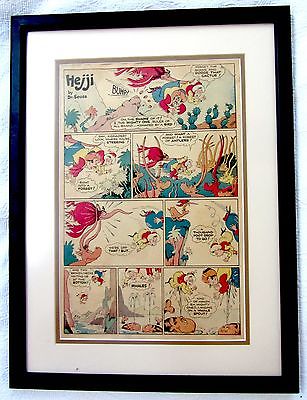Two Framed & Mounted Original 1935 "Hejji" Comic Strip Panels by Dr. Seuss
$
337
Description
Two Impeccably framed and DRY mounted Original Newsprint HEJJI Comic Strip from 1935 by Dr. Seuss.
The original newsprint material can be removed from the frame undamaged. The framer used a DRY MOUNT process to preserve the integrity of the original.
Measurement of the original newsprinted piece is 19 inches by 8.5 inches.
VERY RARE original comic strips on original newsprinted source material in PRISTINE condition.
Kind Thanks for your time. Wishing you a most pleasant day.
Hejji
Dr. Seuss' Hejji (April 7, 1935)Hejji was a short-lived 1935 comic strip, an early work and the only comic strip by prominent children's author Dr. Seuss (pseudonym of Theodor Geisel). Hejji was produced by Geisel during the Great Depression, two years before the publication of his first book.
Distributed by William Randolph Hearst's King Features Syndicate, Hejji began publication on April 7, 1935, as a Sunday strip. A comic strip with an unusually brief publication period, it was cancelled after just three months, the final comic published on June 23, 1935.
The title character was a traveler who, in the first strip, entered the strange land of Baako, which had whales swimming in water-filled volcano craters, a flower broadcasting music and twin goats sharing a single beard. Hejji inadvertently plucks the sacred Trumpet Flower and is promptly arrested. He is taken to the palace of the Mighty One, who has Hejji thrown to the Seven Deadly Wombats. After Hejji escapes, the Mighty One apologizes and gives him a guided tour of Baako. They encounter various creatures and eventually arrive at the mysterious castle of the Evil One.
Dr. Seuss
Dr. Seuss
Geisel in 1957, holding The Cat in the Hat,which inaugurated his Beginner BooksBornTheodor Seuss Geisel
March 2, 1904
Springfield, Massachusetts, U.S.DiedSeptember 24, 1991 (aged 87)
La Jolla, California, U.S.[1]Pen nameDr. Seuss, Theo LeSieg, Rosetta Stone, Theophrastus SeussOccupationWriter, cartoonist, animator, book publisher, artistNationalityAmericanGenresChildren's literatureNotable work(s)
- Horton Hears a Who! (1954)
- The Cat in the Hat (1957)
- How the Grinch Stole Christmas!(1957)
- Green Eggs and Ham (1960)
- The Lorax (1971)
- Helen Palmer Geisel (1927–67)
- Audrey Stone Dimond (1968–91)
Theodor Seuss Geisel (/??a?z?l/; March 2, 1904 – September 24, 1991) was an American writer, poet, and cartoonist. He was most widely known for his children's books written and illustrated as Dr. Seuss. He had used the pen nameDr. Theophrastus Seuss in college and later used Theo LeSieg and Rosetta Stone.
Geisel published 46 children's books, often characterized by imaginative characters, rhyme, and frequent use of anapestic meter. His most-celebrated books include the bestselling Green Eggs and Ham, The Cat in the Hat, The Lorax,One Fish Two Fish Red Fish Blue Fish, The 500 Hats of Bartholomew Cubbins, Fox in Socks, The King's Stilts, Hop on Pop, Thidwick the Big-Hearted Moose, Horton Hatches the Egg, Horton Hears a Who!, and How the Grinch Stole Christmas!. His works have spawned numerous adaptations, including 11 television specials, four feature films, a Broadway musical and four television series. He won the Lewis Carroll Shelf Award in 1958 for Horton Hatches the Egg and again in 1961 for And to Think That I Saw It on Mulberry Street. Geisel also worked as an illustrator for advertising campaigns, most notably for Flit and Standard Oil, and as a political cartoonist for PM, a New York City newspaper. During World War II, he worked in an animation department of the United States Army, where he wrote Design for Death, a film that later won the 1947 Academy Award for Documentary Feature.
He was a perfectionist in his work and would sometimes spend up to a year on a book. It was not uncommon for him to throw out 95% of his material until he settled on a theme for his book. For a writer he was unusual in that he preferred to be paid only after he finished his work rather than in advance.
Geisel's birthday, March 2, has been adopted as the annual date for National Read Across America Day, an initiative on reading created by the National Education Association.
